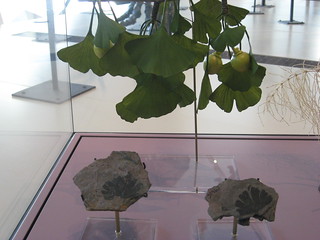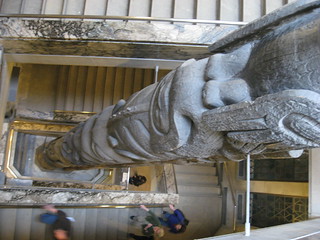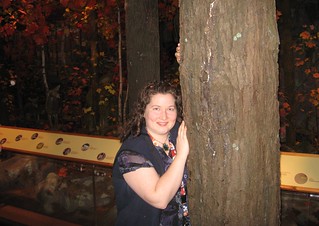The Trees of the ROM
Of all the wonders of nature, a tree in summer is perhaps the most remarkable; with the possible exception of a moose singing “Embraceable You” in spats.
~Woody Allen
Here in the Hands-on Galleries, we care greatly about our trees, which is why we’re so excited about the Earth Weekend events coming up on April 21 and 22nd! In the spirit of the weekend, the ROM Hands-On team thought we’d share our favourite facts about some of the most interesting trees in the ROM’s collections:
They took all the trees
And put ‘em in a tree museum.
~Joni Mitchell, “Big Yellow Taxi”
-
Some of the earliest tree-like plants, the lepidodendrons, lived during the Carboniferous period more than 300 million years ago. When the ROM teachers are giving one of our Dinosaur Gallery lessons, we will often use the lepidodendron fossils from our teaching collections.

Lepidodendron fossil from the Education collections.
-
You can find some ancient Jurassic plants in the James and Louise Temerty Galleries of the Age of Dinosaurs that look very familiar; their descendants are still around today!

Modern and fossil gingko leaves. Can you find them in the dinosaur gallery?
-
The Iconic totem poles that stretch the height of the museum are the tallest objects in the ROM’s collections. They were each carved out of a single western red cedar tree, and are so tall that they had to be installed first and the museum built up around them — the height of the ceiling was determined by the tallest pole. Though the Nisga’a pole erected by Eagle Chief Sagaween is the tallest pole of the 19th century at an impressive 24.5 metres tall, the tallest red cedars can reach heights of over 60 metres!

Why yes, I WAS clinging to the railing for dear life when I took this. That's a LONG way down.
-
The “Tree Cookie” in Life in Crisis: The Schad Gallery of Biodiversity is a 2.3 metre cross-section of a 500-year-old Douglas-fir. This tree was growing when Gutenberg invented the printing press (~1440) and when Darwin published the On the Origin of Species (1859).

That's a biiiig cookie.
-
The trees in the Mixedwood Forest in the Keenan Family Gallery of Hands-on Biodiversity are fibreglass casts of real trees that were growing in Algonquin park when the gallery was being built! How many food chains can you spot in the forest? Can you find the porcupine?

Sarah hugs a tree in Hands-on Biodiversity. As much as we love our trees, we're glad we have lots of them outside, too!
It is difficult to realize how great a part of all that is cheerful and delightful in the recollections of our own life is associated with trees.
~Wilson Flagg
The ROM celebrates Earth Weekend April 21 and 22 with many exciting events, including plasticine art workshops with special guest Barbara Reid and the launch of the Canadian Wildlife Federation Get to Know Contest. Stay tuned to this blog for more details on the goodies we have in store for Earth Weekend at the ROM! For more about daily Hands-on Gallery events, you can also check out the Earth Rangers Studio Green Screens or the #ROMHandsOn twitter tag.
Who leaves the pine-tree, leaves his friend,
Unnerves his strength, invites his end.
~Ralph Waldo Emerson, “Woodnotes”
